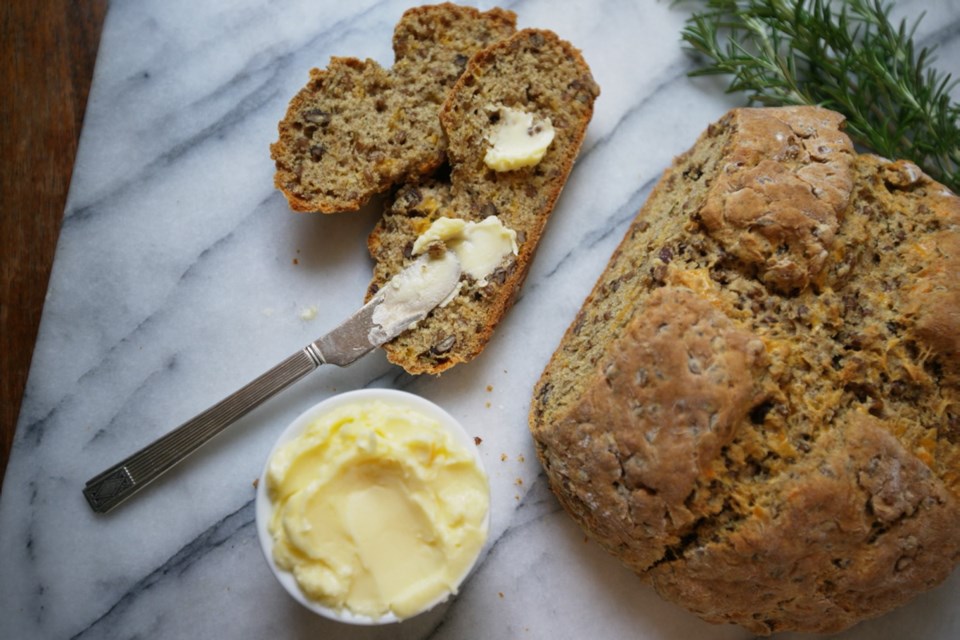 Dear Eric: I bought a bag of wheat berries from Saanichton Farm, thinking I could just add them to my bread dough. But when researching that, I came across conflicting information. The package states they can be cooked, sprouted as a cereal, baked into bread (why I bought them) or used in salads. But nowhere can I find how to do any of those things properly. This is hard, red spring wheat, so ideal for grinding my own flour, but I don’t have a grinder. Do you have any straightforward ideas on how I can use wheat berries?
Dear Eric: I bought a bag of wheat berries from Saanichton Farm, thinking I could just add them to my bread dough. But when researching that, I came across conflicting information. The package states they can be cooked, sprouted as a cereal, baked into bread (why I bought them) or used in salads. But nowhere can I find how to do any of those things properly. This is hard, red spring wheat, so ideal for grinding my own flour, but I don’t have a grinder. Do you have any straightforward ideas on how I can use wheat berries?
Patricia
Dear Patricia: Saanichton Farm is on the Saanich Peninsula and has been operated by four generations of the Rashleigh family since the 1930s.
Running the farm today are Bryce and Jill Rashleigh and their family. Although they raise turkeys and chickens, their focus the last while has been on growing red lentils, malting barley, used by several local breweries, and hard red spring wheat.
Their wheat berries, whole, hulled wheat kernels, are, of course, harvested from that wheat. They are very nutritious, as they contain the bran, germ and endosperm.
Hard, red spring wheat is considered specialty wheat because of its strong gluten characteristics and high protein content. When the wheat berries are ground into whole-wheat flour, which Saanichton Farm also sells, it’s excellent for use in breads, bagels and noodles.
But Patricia bought wheat berries and is not equipped with a home mill to grind them into flour. Not a problem, really, because she can use those wheat berries in many other satisfying ways.
When I want to use them, I’ll start by simmering wheat berries in a generous amount of water until tender, not unlike the way you would cook other grains, such as pot barley.
For example, to cook one cup of wheat berries, I’ll simmer them in a tall pot with 12 cups of water until tender. Because they are whole kernels and it’s hard winter wheat, they do take a while to become tender, about 60 to 70 minutes. And even when they are cooked, they’ll still be chewy, a quality I enjoy.
Some sources say to salt the water when cooking wheat berries; others do not. I don’t because I’m always adding salt to the creations I make with wheat berries.
When the one cup of wheat berries you started with are cooked and drained, because they are now plumped up, you have about 2 3/4 cups of them.
You could swirl those warm wheat berries into soups or stews, or mix them into sautéed mushrooms flavoured with garlic and herbs to create a hot side dish. You could also stir some into hot milk and make a porridge.
When cooled, wheat berries can go in salads, as you would other grains, such as couscous or bulgur. Or use them in a stuffing for bell peppers, cabbage rolls or perogies.
The cooked, cooled wheat berries could also be worked into bread dough, whether it’s leavened by yeast or baking soda. I took the latter approach in today’s soda-bread recipe, which yields a hearty loaf rich with protein and fibre. Thanks to those wheat berries and other tastes, such as cheese, rosemary and walnuts, it’s also very flavourful.
Saanichton Farm wheat berries are available in Greater Victoria at places such as Dan’s Market, Pepper’s Foods, the Root Cellar, Carnivore Meats and Niagara Grocery. You can also buy them at the farm, 1947 Stelly’s Cross Rd.
For more information about the farm, including other businesses selling their products, go to saanichtonfarm.com.
Wheat berries should be stored in an airtight container in a cool, dry place. If you have a pile of them, though, and won’t use them up in a few months, store them in the fridge, where they’ll keep a year or even more.
Note: I didn’t have room to get into the details of this, but some folks also like to soak and sprout wheat berries. I plan to discuss that topic in a future column.
Soda Bread with Wheat Berries, Cheese and Rosemary
Dense, delicious bread to serve for breakfast with eggs or marmalade; for lunch with soup or to make sandwiches with; or for dinner, sliced and served alongside stews.
Preparation: 30 minutes
Cooking time: 35 to 38 minutes
Makes: one large loaf
1/2 cup Saanichton Farm wheat berries
8 cups water
1 1/4 cups whole-wheat flour
1 1/4 cups all-purpose flour
1 1/2 tsp baking soda
1/2 tsp salt
1/4 cup butter, cold, cut in small cubes
1 cup grated old cheddar cheese
1 Tbsp chopped fresh rosemary
1/2 cup chopped walnuts
1 1/3 cups buttermilk
Place the wheat berries and water in a pot and bring to a simmer over medium-high heat. Adjust the heat to maintain that simmer (small bubbles should just break on the surface of the water). Simmer wheat berries until tender, but still a little chewy, about 60 to 70 minutes.
When cooked, drain the wheat berries well, and then cool to room temperature.
Set an oven rack in the middle of the oven, then preheat the oven to 425 F. Line a baking sheet with parchment paper.
Place the flours, baking soda and salt in a bowl and whisk well to combine.
Using your fingers, two forks or a pastry cutter, work the butter into the flour mixture until thoroughly distributed. Mix in the cheese, cooked wheat berries, rosemary and walnuts. Gently mix in the buttermilk until a loose, fairly wet dough forms. (You want the dough to be fairly wet, as the wheat berries will absorb that added moisture when the loaf bakes.)
Lightly dust a clean work surface and your hands with flour. Turn the dough onto the counter and shape it into a round, squat loaf about 15 centimetres wide.
Place the shaped dough on the prepared baking sheet. Using a knife lightly dusted with flour, cut a shallow X into the centre of the loaf.
Bake the bread for 35 to 38 minutes, or until the loaf springs back when gently touched in the centre. Allow to cool to room temperature on a baking rack, then serve.
Eric Akis is the author of eight cookbooks. His latest is The Great Rotisserie Chicken Cookbook (Appetite by Random House). His columns appear in the Life section Wednesday and Sunday.

